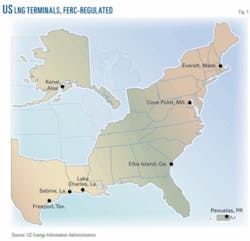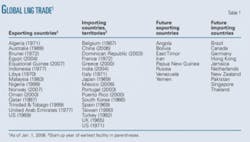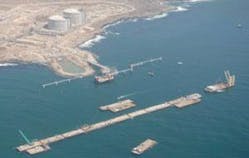Establishing critical parameters in screening for siting LNG terminals helps focus eventual development on the objectives of the principal stakeholders: developer, supplier, and end users. Proper site selection and design can determine whether a site is acceptable for further consideration and study. Further study may reveal additional site deficiencies, but high-level initial screening focuses work on the most viable sites.
This first of two articles assesses the factors leading to onshore or offshore terminal location and the influence of LNG vessels on potential marine terminal siting. The concluding article, next week, will consider land requirements for onshore locations, including soil and seismic conditions and site elevations.
Parameters discussed in the two articles include:
- LNG import-export facility physical criteria. These include population density, plant area, maximum-minimum distance from loading-unloading to storage, type of storage, site elevation relative to 100-year flood elevation, approach channel width and depth, any constraints on ship passage (such as bridges or overhead power lines), maneuvering area and depth, required underkeel clearance, environmental limitations (wind, wave, current), need for breakwater, allowable downtime, and availability of tugs.
- LNG vessel characteristics. Vessel type (membrane, spherical, or barge), vessel capacity, length overall, beam, depth, loaded, and draft air draft.
- LNG pipeline. Pipeline capacity, proximity to regasification site, commercial requirements, gas quality, and proximity to end users.
Identification of potential sites for development into export-import terminals is an essential first step in predevelopment of any LNG project. Setting critical parameters to be used in the screening process helps focus a project on the principal stakeholders’ objectives.
Background
Good site selection can eliminate or minimize many of the hazards and risks associated with shipping, storage, and sendout from terminals.1 It is in the best interests of the industry that its safety record remains clean.
As of May 2008 five import terminals and one export plant were operating in the US, with many more being designed or constructed. Terminals operating as of May 2008 were:2
- Everett, Mass.
- Cove Point, Md.
- Elba Island, Ga.
- Lake Charles, La.
- Gulf Gateway Energy Bridge, Gulf of Mexico.
- Penuelas, PR.
- Sabine, La.
- Freeport, Tex.
- Kenai, Alas. (the only export plant). Kenai exports LNG to Japan.
Fig. 1 shows terminals under jurisdiction of the US Federal Energy Regulatory Commission. Gulf Gateway Energy Bridge is under US Maritime Administration jurisdiction. Several terminals have planned commissioning dates in 2008. FERC lists 47 North American proposed or expanded terminals.3
At the beginning of 2008, worldwide there were 26 liquefaction plants in 15 countries. In contrast, there were 60 import, or regasification, marine terminals, on or offshore, spread across 18 different countries. More than 270 LNG tankers deliver LNG to more than 40 ports around the world.
In addition to these terminals, about 73 liquefaction projects and 182 regasification projects are either proposed or under construction around the world. Proposed terminals will likely not all be constructed. Table 1 lists countries having present or future export and import terminals.4 The locations display a wide variety of likely design conditions. Some of the countries lie in high seismic zones, some in areas where typhoons or hurricanes could affect operations.
Rigorous siting reviews coupled with separation and distance requirements found in US safety codes can reduce risk to the public. Other countries have similar requirements. Dangers to the public from a catastrophic event can also be reduced or eliminated by establishing appropriate separation distances early in a project.
Design guidelines
The LNG industry has established an excellent safety record over the years. Since Sept. 11, 2001, however, the public has become increasingly concerned about vulnerability to terrorist attacks. The LNG industry has not escaped resulting heightened public scrutiny. Some of the concern stems from public misconceptions about the properties of LNG. The industry has tried to ease these concerns with factual documents providing information in an understandable form. Public agencies have also implemented measures to further reduce public risk. In Boston Harbor, the US Coast Guard has put the waters near any LNG ship off limits to small boats or any kind of shipping.
The US Department of Energy says LNG tankers are unlikely to explode. LNG only becomes flammable if it vaporizes and mixes with air in the correct proportions. LNG is not transported under pressure but in cryogenic liquid form under normal atmospheric pressure. Finally, the tankers are built to withstand incidents such as collisions or bad weather and their multihull design has proven to be robust. Eight incidents involving LNG tankers spilling their cargoes have occurred over the last few decades and in no case was there an explosion or fire. Released LNG typically regasifies and disperses, rising harmlessly into the atmosphere, according to DOE.5
Site selection
Site selection for import or export terminals depends on a site’s proximity to gas markets or production areas, respectively. Once a general location has been identified, establishing critical parameters a site must meet allows evaluation of alternative sites within that area.
These parameters include land area and use, existing marine facilities, adjacent and nearby property use, population density, maximum-minimum distance from loading-unloading to storage, type of storage, site elevation relative to 100-year flood elevation, approach channel width and depth, any constraints on ship passage (bridges, overhead power lines, etc.), maneuvering area and depth, required underkeel clearance, environmental limitations (wind, wave, current), need for breakwater, allowable downtime, and availability of tugs.
Pipeline capacity, proximity to regasification site, commercial requirements, gas quality, and location relative to end users also stand as important considerations. The ultimate goal of site selection is to reduce transportation and storage costs. A preferred terminal site allows freedom of choice in design of the facilities and lets the operator safely carry out its activities.
Offshore facilities
Insufficient or inappropriate available land areas, densely populated or recreational areas, and shallow or narrow waterways can each prompt offshore siting instead. An offshore facility may also prove desirable if the shoreline is sensitive to nearshore development affecting marine life or ecosystems. Environmental conditions such as wind, waves, and current will influence the detail design and layout of an offshore terminal. Political hurdles such as permit approvals in the US also need to be addressed.
LNG transfer in unprotected open water requires either calm conditions or new transfer technology capable of tolerating higher sea states. Active joint industry projects (JIPs) are developing this technology.6
Onshore facilities
Location influences the design of onshore LNG facilities. Environmental conditions and the concentration and activities of the population surrounding the site influence detailed design and layout. Onshore facilities need to be as close as practicable to the marine operations, preferably adjacent. Such siting reduces the length and diameter of expensive piping runs, avoids the potential risk of running piping past or through other facilities, and provides an integrated operating environment. Distance from a terminal’s tanks to carrier should be less than 6 km, preferably less than 2.
Metocean conditions such as wind, wave, and current also require consideration. Sea states potentially encountered along the shoreline of an open ocean may prevent an LNG carrier from docking and could result in motions extending beyond a reasonable working range for the arms unloading the ship.
A breakwater may be required to reduce such motions. Sempra’s Costa Azul terminal in Baja California, Mexico, uses such a breakwater (Fig. 2). The need for a breakwater adds to the cost of the terminal, prompting the interest in JIPs to develop new transfer technology requiring less breakwater protection.
Proximity to a commercial pipeline for gas distribution also bears consideration in determining an LNG import terminal’s potential location. Even if a pipeline lies close to the facility, it may not have adequate capacity for sendout. If no pipeline exists, one may need to be built or an alternative means for transporting gas to market explored (barges, trucks, or rail). Any preexisting pipeline will also have commercial and gas-quality requirements.
LNG vessels
As of Aug. 7, 2008, 275 LNG carriers were in service. The largest commissioned vessels at that time, Teekay LNG’s Al Huwaila and its sister ships, have a capacity of 217,000 cu m.7 About 102 carriers were on order, with 28 planned for delivery during the balance of 2008.8 Vessels with capacities as large as 267,000 cu m are under construction. These larger vessels measure 990-1,150 ft long and 164-180 ft wide. Loaded draft measures 38-39.4 ft. Some of the larger vessels also have large air draft requirements. Table 2 lists some typical vessel characteristics.
LNG vessels typically berth for about 24 hr. The USCG provides security inspection and monitors the vessel while in transit to the terminal. This typically has little effect on other vessel traffic if it is a one-way channel.
Vessels transport the equivalent of between 2.0 bcfd for an 88,000 cu m vessel and 4.6 bcfd for a 216,000 cu m vessel, yielding the following delivery schedule for a 138,000 cu m vessel, depending on terminal throughput capacity:
- 5.8 million tonnes/year (0.75 bcfd), one vessel about every 4 days.
- 7.75 million tonnes/year (1.0 bcfd), one vessel about every 3 days.
- 10 million tonnes/year (1.3 bcfd), one vessel every 2 days.
- 20 million tonnes/year (2.6 bcfd), one vessel every day.
References
- Society of International Gas Tankers and Terminal Operators (SIGTTO), “Site Selection and Design for LNG Ports and Jetties, Information Paper No. 14,” 1st Ed., January 1997.
- http://www.ferc.gov/industries/lng.asp.
- http://www.ferc.gov/industries/lng/indus-act/terminals/exist-prop-lng.pdf.
- http://www.energy.ca.gov/lng/index.html.
- http://www.fossil.energy.gov/programs/oilgas/storage/index.html.
- http://www.gazdefrance.com/EN/A/3158/transfer-technology-for-tomorrows-lng-supply-chains.html.
- http://www.shipbuildinghistory.com/world/highvalueships/lngactive-fleet.htm.
- http://www.shipbuildinghistory.com/world/highvalueships/lngorder-book.htm.
Based on presentation to Offshore Technology Conference, Houston, May 5-8, 2008.
The authors
Tere R. Sonne ([email protected]) is senior project manager with Technip USA Inc. in Houston. She has done extensive work toward an MS in structural-geotechnical engineering at the University of Houston, holds a BS in civil engineering (1983) from Florida Institute of Technology, and a BS in zoology from the University of Georgia (1979). She is a member of the Marine Technology Society and a board member of the John C. Freeman Weather Museum. She was a cochairman for a special session on LNG at the 2008 Offshore Technology Conference in Houston, Texas. She has worked on numerous LNG projects worldwide for several major oil companies.
John G. Bomba ([email protected]) is senior principal engineer at Technip USA Inc. in Houston. He has also served as chief engineer at RJ Brown Far East Pty. Ltd., Singapore, and RJ Brown Deepwater, Houston. He holds a BS in petroleum engineering (1954) from Texas A&M University, and has done postgraduate work in structural engineering at Texas A&M and the University of Tulsa. He is a life fellow of the American Society of Civil Engineers, a member of the American Society of Mechanical Engineers, and a member of the Marine Technology Society.







